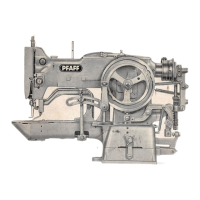B.
Instructions
for
Mechanics
16.
Ceniering
the
Needle
In
the
Needle
Hole
Needle
bar
frame
F (Fig. 12) is
hinged
to a
stud
at
its
upper
end
and
held
In
place
by
screw
e, which
passes
through
an
elongated
hole
In
the
casting.
To
center
the
needle
In
the
needle
hole,
loosen
screw
e
and
move
the
needle
bar
frame
to
the
right
or
left,
as
appropriate.
The
needle
plate
has
an
Interchangeable
Insert.
If
the
needle
hole
Is
damaged,
loosen
the
two
set
screws
and
press
the
Insert
up
out
of
Its
seat.
In
Inserting
a
new
Insert,
make
sure
the
groove
on Its
underside
Is
exactly
In
line
with
the
knife
guide
groove
In
the
needle
plate.
17.
Timing
the
Shuttle
The
Pfaff 3334-958/01 Is fitted for a
needle
bar
rise
(amount
of
needle
rise
required
to
form the loop) of
V32",
or 2.4 millimeters. To facilitate this adjustment,
use
the Pfaff
needle
rise
gauge
No.
88013605
which
Is
available
on
special
request.
In timing
the
shuttle,
apply
this
rule:
When
the
needle
has
passed
the
lowest
point
of
Its
stroke
and
risen
Vn
of an Inch,
the
point
of
the
shuttle
should
be
just
opposite
the
center
line
of
the
needle.
This
setting
ensures
proper
loop
formation.
If
adjustment
is
required,
loosen
shuttle
driver
screws
bi
and
b: (only bi
visible
In Fig.
21),
which
can
be
reached
through
holes
ai
and
aj
on
the
underside
of
the
cylinder
arm.
Ttie
shuttle
driver
crank
Is
pinned
to
the
rear
end
of
the
shuttle
driver
shaft
so
that
its
position
on
the
shaft
cannot
be
adjusted.
Setting
the
Needle
Bar
at
Correct
Height
See
that
the
point
of
the
shuttle
Is
opposite
the
center
line
of
the
needle
after
the
latter
has
passed
the
lowest point of Us
stroke
and
risen
V22
of an Inch. When In
this
position,
the
point of
the
shuttle
should
be Vu" (1.5 millimeter)
above
the
top of
the
needle
eye. If
adjustment
is
required
loosen
the
clamping
screw,
which
fastens
the
needle
bar
con
necting
stud
to
the
needle
bar,
and
move
the
latter
up
or
down,
as
appropriate.
To
double
check
the
above
settings,
bring
the
needle
to
the
lowest
point
of its
stroke
and
see
If
the
bottom
of
the
needle
eye
Is flush with
the
top
of
the
shuttle
driver
when
the
latter
Is at Its right
point
of
reversal.
Also
check
If
the
amount
of
needle
rise
Is
the
same
whether
the
driving
pulley
Is
turned
clockwise
or
counter-clockwise.
Both
the
shuttle
driver
and
the
needle
bar
should
reach
their
points
of
reversal
at
exactly
the
same
time.
18.
Adjusting
the
Crosswise
Clamp
Travel
The
feed
across
motion
Is
derived
from
the
slot
on
the
front
of
feed
cam
W (Fig. 13).
As
the
roller
on
stud
Pi
follows
the
channel
track,
the
throw
which
Is
Initiated
by
the
curvature
of
the
slot
Is
conveyed
to
feed
across
regulator
H,
connection
Q, ball
stud
R,
feed
across
shaft
S
and
feed
plate
carrier
U,
and
causes
the
latter
to move
crosswise
of
the
cylinder
arm.
Adjust the feed
across
motion so that the right and left hand
ends
of the feed plate slot
are equidistant from the needle hole when the feed plate Is at the extreme right or left
of Its throw. Check this setting for the longest and the
shortest
feed
across
motion.
All
motions
should
be
timed very carefully.
Once
the
correct
setting
has
been
obtained,
no further
adjustment
should
be
made,
unless
absolutely
necessary.
If
readjustment
Is required,
proceed
as
follows;
1. After
the
machine
has
completed
the
sewing
cycle
and
stopped,
loosen
the
nut on
roller
stud
Pi (Fig. 13)
and
center
the
stud
In
the
elongated
hole
of
feed
across
re-
^
gulator
H.
Tighten
the
nut
securely.
2. Move ball
stud
G (Fig. 13)
toward
you
as
far
as
it will go,
setting
clamp
and
feed
plate
for
the
longest
crosswise
travel.
3.
Push
the
belt
shifter
over
from
you
to
release
the
brake.
4.
Turn
the
driving pulley
and
chedt
whether
the
right
and
left
hand
ends
of
the
feed
plate
slot
are
equidistant
from
the
needle
hole
when
the
feed
plate
is at
the
extreme
right
or
left of Its throw. If
adjustment
Is
required,
loosen
screw
h
and
binding
screw
m (Fig. 16)
and
set
the
feed
plate,
as
appropriate.
Then
tighten
both
screws
securely.
5. Move ball stud G (Fig. 13) over from you as far
as
it will go, setting
clamp
and feed
plate
for
the
shortest
crosswise
travel.
6.
Repeat
the
check
outlined
In
par.
4
above.
If
adjustment
is
required,
loosen
screws
I2
and
n (Fig. 16)
and
move
stud
R
lengthwise
of
the
feed
across
shaft
until
the
crosswise
travel of
the
work
clamp
Is exactly halved by
the
needle.
To
double
check
this setting, move ball
stud
G (Fig. 13) from
one
end
of
the
slot
In
regulator
H to
the
other
and
make
sure
the
feed
plate
does
not
move
sideways.
If
the
feed
plate
should
move
sideways
In
spite
of
this
minute
adjustment,
move
stud
Pi (Fig. 18) slightly to
the
right
or
left In
the
elongated
hole of feed
across
regulator
H.
R
5782
Fig.
16
h, R
• /
,'
I
m I2 n

